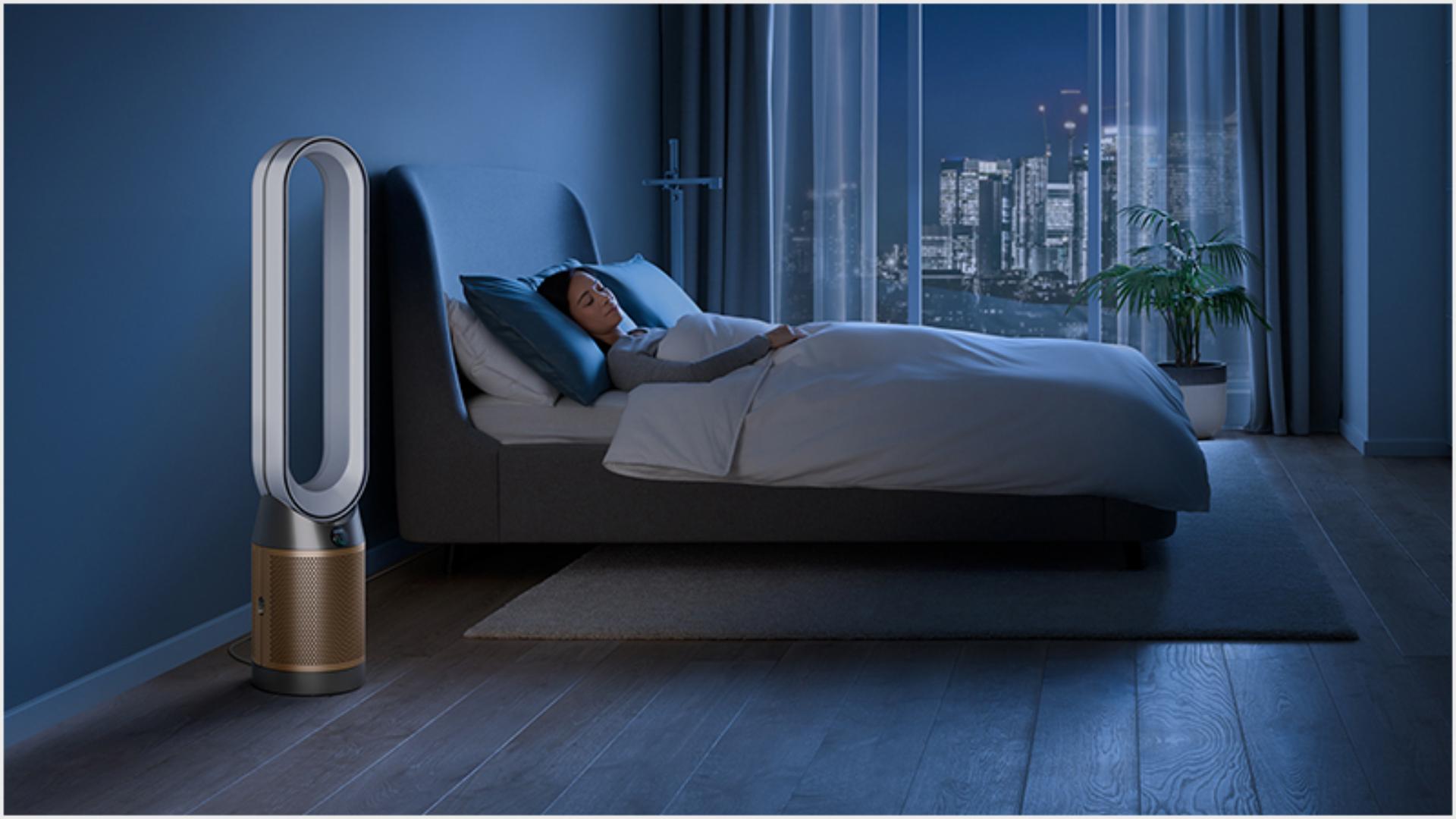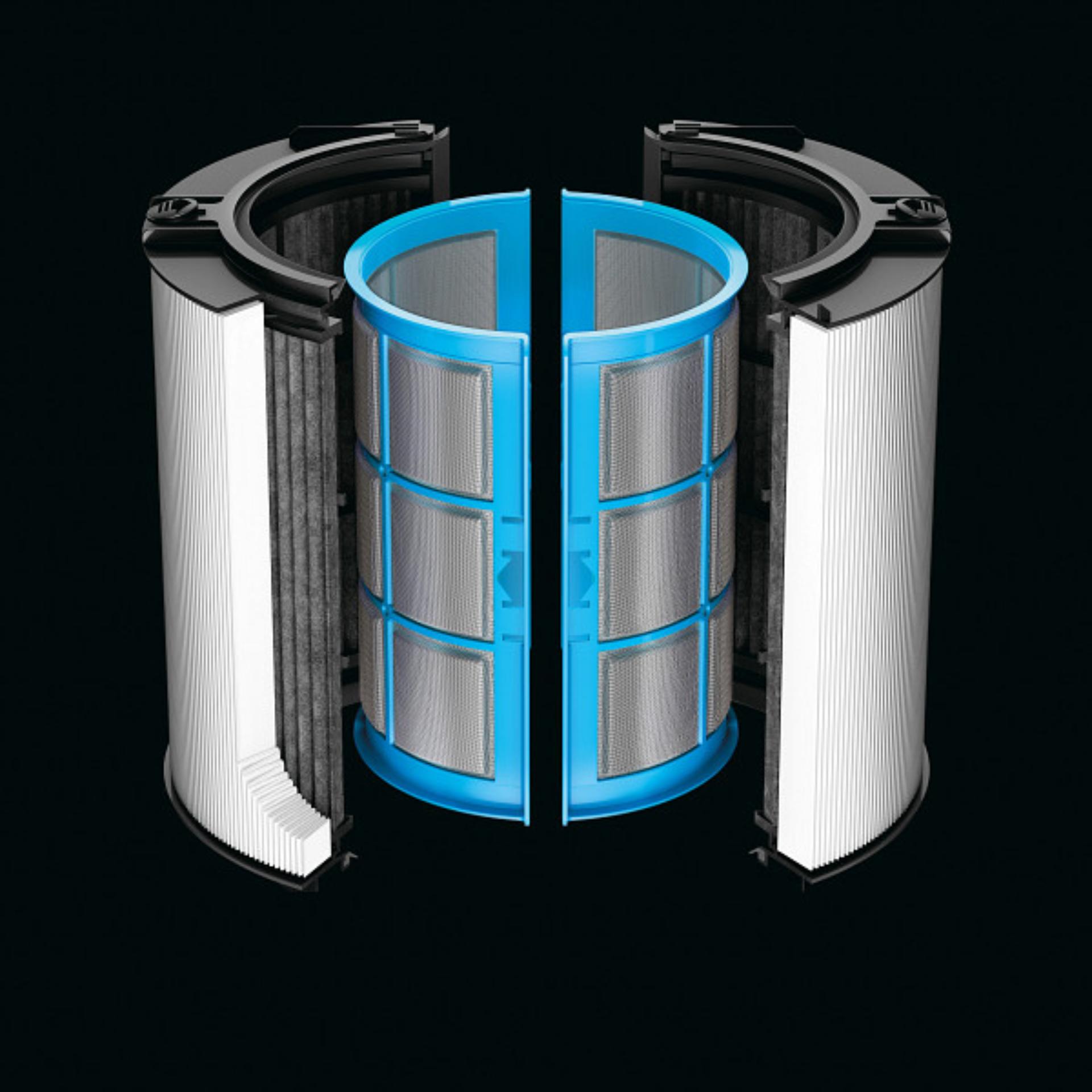
Dyson launches air purifier with new sensing technology to destroy potentially dangerous indoor pollutants
Millions of people around the world are spending more time indoors. With all new solid-state formaldehyde sensing, fully-sealed HEPA 13 standard filtration and 20% quieter airflow projection, the new Dyson Purifier Cool range ensures a cleaner home environment.
22 April 2021Introducing our latest generation of purification machines with new solid-state formaldehyde sensing technology, the new Dyson Purifier Cool range is designed to capture ultrafine dust and allergens, even destroying potentially dangerous VOCs including formaldehyde .
Formaldehyde is a colourless gas pollutant, released by furniture and wooden products containing formaldehyde-based resins like plywood and fibreboard, insulating materials and products such as paint, wallpapers, varnishes and household cleaning products . Being 500 times smaller than particles the size of 0.1 microns, it is particularly difficult to capture and if left undetected can lead to prolonged exposure due to continuous release of airborne chemicals, known as off-gassing.
While other gel-based formaldehyde sensors can deteriorate overtime and are easily confused with other VOC pollution, Dyson’s new, solid-state formaldehyde sensor works alongside Dyson’s unique algorithm to precisely monitor formaldehyde levels - intelligently ignoring other gases which are detected by a dedicated VOC sensor.
Tireless and ever-dissatisfied, Dyson engineers have also re-engineered the machine airflow pathways to achieve sealed HEPA 13 standard filtration – not only ensuring that no air bypasses the filter but blocking any potential leak points through which dirty air might enter the airflow. This means Dyson’s latest purifiers remove 99.95% of particles as small as 0.1 microns . Improvements of the airflow journey have made the Dyson Pure Cool and Dyson Pure Cool Formaldehyde 20% quieter , without any compromise on purification performance to reduce unwanted noise at home.
What can you do to reduce formaldehyde within your home?
As well as selecting DIY and renovation products that don’t contain formaldehyde, increasing ventilation and using purification within a space can help to remove the gas from your home. Dyson’s new Purifier Formaldehyde range not only sense formaldehyde with their intelligent solid-state sensor, but they also destroy it, using Dyson’s Selective Catalytic Oxidisation (SCO) filter.
Some formaldehyde sensors are gel-based, so can dry out over time, causing the precision and performance of the sensor to deteriorate. Dyson’s formaldehyde sensor is solid-state, and so doesn’t dry out, lasting the lifetime of the machine. Its intelligent algorithm precisely senses formaldehyde levels without confusing it with other VOCs.
As well as sensing formaldehyde, Dyson’s SCO filter captures and destroys the pollutant at a molecular level, breaking it down into tiny amounts of water and CO2. It then regenerates from the oxygen in the air to keep destroying it continuously without ever requiring replacement.
-

-
Dyson’s commitment to providing cleaner air
“Our latest technology helps make homes more hygienic at a time when 90% of our time is spent indoors. We are all cleaning more frequently and unknowingly surrounding ourselves with pollution sources like formaldehyde which can be released from paint, pressed wood and new furnishings. We have developed a purifier which senses particulate matter and VOCs, working to capture them, destroying formaldehyde for a lifetime.”
James Dyson, Chief Engineer and Founder
The Indoor Generation
Every day, humans breathe up to 9,000 litres of air 7, and even before the COVID-19 pandemic spent as much as 90% of their time indoors 8. As our homes increasingly become spaces where we work and exercise as well as sleep and play, the quality of the air we breathe in all aspects of our routine is non-negotiable.
There are a number of indoor pollution sources, which release pollutants like PM10, PM2.5, VOCs, NO2 and formaldehyde into the air. Sources of pollution are present in all aspects of our daily lives, whether that be PM2.5 emitted when cooking, VOCs released from cleaning products or the continuous off-gassing of formaldehyde from our living room furniture. Tirelessly improving and constantly iterating, Dyson’s new Purifier Formaldehyde range reflects the latest technology in three core areas: sensing, filtration and acoustics.
Precise formaldehyde sensing and destruction
In addition to the existing particle, NO2, VOCs, temperature and humidity sensors, the integration of an intelligent formaldehyde sensor ensures precise sensing of the pollutant for the lifetime of the machine.
Formaldehyde sensors can be gel-based and may deteriorate gradually as they dry out over time. Using an electro-chemical cell, the Dyson formaldehyde sensor does not dry out and its unique intelligent algorithm cross-checks data every second, selectively sensing to avoid confusion with other VOCs.
-

-
Dyson’s Selective Catalytic Oxidisation (SCO) filter continuously destroys formaldehyde at a molecular level 9. The catalytic filter has a unique coating, with the same structure as the Cryptomelane mineral. Its billions of atom-sized tunnels are the optimal size and shape to trap and destroy formaldehyde, breaking it down into tiny amounts of water and CO2 . It then regenerates from oxygen in the air to keep destroying it continuously without ever requiring replacement.
“The off-gassing tendency of formaldehyde means that it can go undetected in a home for years. Dyson has engineered a machine that provides accurate and successful sensing, capture and destruction of the pollutant. Our solid-state sensor doesn’t dry out overtime, lasting the lifetime of the machine. The COVID-19 pandemic has raised global awareness about the air that we breathe and Dyson’s commitment to providing cleaner air through innovation and technology remains at the forefront of our mission.”
Alex Knox, Vice President of Environmental Care at Dyson
Full-machine HEPA filtration10
In Dyson’s new purifiers, it’s not just the filter that meets HEPA H13 standard, but the whole machine. It captures virus11 and 99.95% of particles as small as 0.1 microns12 such as allergens, bacteria and dust. Dyson engineers took a forensic approach to achieving a fully-sealed machine, creating high pressure seals at an additional 24 critical points to prevent dirty air from bypassing the filters and carrying pollutants back into the room.
Dyson Purifier Cool: Acoustically engineered to be 20% quieter14
Dyson engineers increased efforts to further reduce the sound output of the Dyson Purifier Cool while maintaining purification performance. Through an iterative design, test, build process managed at the Dyson Malaysia Development Centre’s in-house acoustics chamber, the machine was re-engineered to be 20% quieter15. To achieve this noise reduction, Dyson engineers refined the overall airflow path by widening the aperture (slot in which the air exits the machine) and its geometry was improved. This reduced the amount of friction between the air and surface of the machine, resulting in less sound. Noise was reduced from 64 to 61 decibels at max fan speed.
Air Multiplier™ Technology
Using Dyson Air Multiplier™ Technology, the machine can project purified air to every corner of the room 16. Auto mode enables the machine to maintain a preferred room temperature17 and air quality levels, while the machine can be entirely controlled by the Dyson Link App and activated by voice control18.
Engineered for real homes
Dyson purifier machines are engineered for real spaces. The industry standard for testing air purifiers measures performance using a laboratory test conducted in a compact chamber 12m2 in size, with a ceiling fan to circulate the air and one sensor inside the room measuring air quality. For more representative testing, Dyson’s POLAR test is based on a larger room size of 27m2 with no added fan and uses eight sensors in the corners of the room and one sensor in the centre to collect air quality data.
[1] Particle challenge by DEHS oil specified in EN1822 within a chamber specified in ASTM F3150. Tested in Max Mode at IBR US, for whole machine efficiency above 99.95%.
[2] 20% quieter than Dyson’s predecessor machine, applies to Dyson Pure Cool and Dyson Pure Cool Formaldehyde only.
[3] Third party full machine testing based on GB/T 18801-2015 formaldehyde cumulative clean mass testing with continuous injection until plateau of formaldehyde CADR is achieved. Results may vary in practice.
[4] WHO guidelines on indoor air quality: selected pollutants, World Health Organisation, 2010.
[5] Tested for filtration efficiency at 0.1 microns (EN1822, ISO29463).
[6] 20% quieter than Dyson’s predecessor machine, applies to Dyson Pure Cool and Dyson Pure Cool Formaldehyde only.
[7] ‘How your lungs get the job done’ American Lung Association, 2017.
[8] ‘Combined or multiple exposure to health stressors in indoor built environments,’ World Health Organization Regional Office for Europe, Edited by Dimosthenis A Sarigiannis, pg 9, 2013.
*Whole machine tested by independent third-party laboratory Airmid (Ireland) for capture of Influenza A (H1N1)
[9] Third party full machine testing based on GB/T 18801-2015 formaldehyde cumulative clean mass testing with continuous injection until plateau of formaldehyde CADR is achieved. Results may vary in practice.
[10] 1 Particle challenge by DEHS oil specified in EN1822 within a chamber specified in ASTM F3150. Tested in Max Mode at IBR US, for whole machine efficiency above 99.95%.
[11] Tested on Influenza A (H1N1) under technical conditions resulting in reduction of airborne virus by 99% (in 28.5m3 area). Results may vary.
[12] Tested for filtration efficiency at 0.1 microns (EN1822, ISO29463).
[14] 20% quieter than Dyson’s predecessor machine, applies to Dyson Pure Cool and Dyson Pure Cool Formaldehyde only.
[15] 20% quieter than Dyson’s predecessor machine, applies to Dyson Pure Cool and Dyson Pure Cool Formaldehyde only.
[16] In maximum setting. Tested for air projection (DTM 801) and purification coverage in a 81m3 room (TM-003711).
[17] Applies to heating function only.
[18] Requires device to run app, Wi-Fi or mobile data, Bluetooth 4.0 support, and iOS version 10 or Android version 5 (or above). Standard data and messaging rates may apply. Voice control requires compatible device.

Yvette Yeo
Email:yvette.yeo@dyson.com